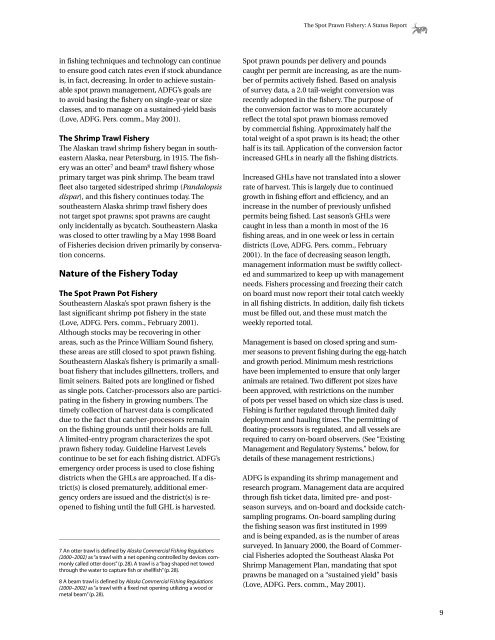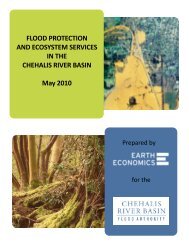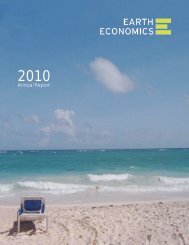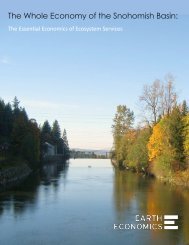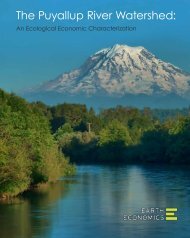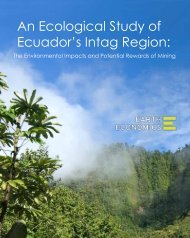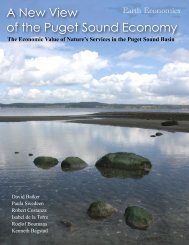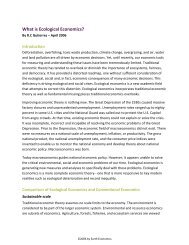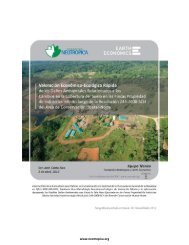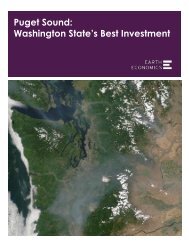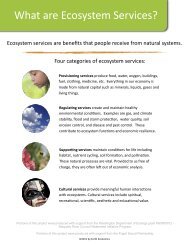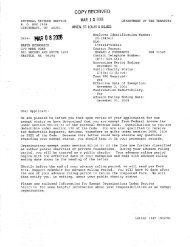The Spot Prawn Fishery: A Status Report - Earth Economics
The Spot Prawn Fishery: A Status Report - Earth Economics
The Spot Prawn Fishery: A Status Report - Earth Economics
You also want an ePaper? Increase the reach of your titles
YUMPU automatically turns print PDFs into web optimized ePapers that Google loves.
<strong>The</strong> <strong>Spot</strong> <strong>Prawn</strong> <strong>Fishery</strong>: A <strong>Status</strong> <strong>Report</strong><br />
in fishing techniques and technology can continue<br />
to ensure good catch rates even if stock abundance<br />
is, in fact, decreasing. In order to achieve sustainable<br />
spot prawn management, ADFG’s goals are<br />
to avoid basing the fishery on single-year or size<br />
classes, and to manage on a sustained-yield basis<br />
(Love, ADFG. Pers. comm., May 2001).<br />
<strong>The</strong> Shrimp Trawl <strong>Fishery</strong><br />
<strong>The</strong> Alaskan trawl shrimp fishery began in southeastern<br />
Alaska, near Petersburg, in 1915. <strong>The</strong> fishery<br />
was an otter 7 and beam 8 trawl fishery whose<br />
primary target was pink shrimp. <strong>The</strong> beam trawl<br />
fleet also targeted sidestriped shrimp (Pandalopsis<br />
dispar), and this fishery continues today. <strong>The</strong><br />
southeastern Alaska shrimp trawl fishery does<br />
not target spot prawns; spot prawns are caught<br />
only incidentally as bycatch. Southeastern Alaska<br />
was closed to otter trawling by a May 1998 Board<br />
of Fisheries decision driven primarily by conservation<br />
concerns.<br />
Nature of the <strong>Fishery</strong> Today<br />
<strong>The</strong> <strong>Spot</strong> <strong>Prawn</strong> Pot <strong>Fishery</strong><br />
Southeastern Alaska’s spot prawn fishery is the<br />
last significant shrimp pot fishery in the state<br />
(Love, ADFG. Pers. comm., February 2001).<br />
Although stocks may be recovering in other<br />
areas, such as the Prince William Sound fishery,<br />
these areas are still closed to spot prawn fishing.<br />
Southeastern Alaska’s fishery is primarily a smallboat<br />
fishery that includes gillnetters, trollers, and<br />
limit seiners. Baited pots are longlined or fished<br />
as single pots. Catcher-processors also are participating<br />
in the fishery in growing numbers. <strong>The</strong><br />
timely collection of harvest data is complicated<br />
due to the fact that catcher-processors remain<br />
on the fishing grounds until their holds are full.<br />
A limited-entry program characterizes the spot<br />
prawn fishery today. Guideline Harvest Levels<br />
continue to be set for each fishing district. ADFG’s<br />
emergency order process is used to close fishing<br />
districts when the GHLs are approached. If a district(s)<br />
is closed prematurely, additional emergency<br />
orders are issued and the district(s) is reopened<br />
to fishing until the full GHL is harvested.<br />
__________________________________________________________<br />
7 An otter trawl is defined by Alaska Commercial Fishing Regulations<br />
(2000–2002) as “a trawl with a net opening controlled by devices commonly<br />
called otter doors” (p. 28). A trawl is a “bag-shaped net towed<br />
through the water to capture fish or shellfish” (p. 28).<br />
8 A beam trawl is defined by Alaska Commercial Fishing Regulations<br />
(2000–2002) as “a trawl with a fixed net opening utilizing a wood or<br />
metal beam” (p. 28).<br />
<strong>Spot</strong> prawn pounds per delivery and pounds<br />
caught per permit are increasing, as are the number<br />
of permits actively fished. Based on analysis<br />
of survey data, a 2.0 tail-weight conversion was<br />
recently adopted in the fishery. <strong>The</strong> purpose of<br />
the conversion factor was to more accurately<br />
reflect the total spot prawn biomass removed<br />
by commercial fishing. Approximately half the<br />
total weight of a spot prawn is its head; the other<br />
half is its tail. Application of the conversion factor<br />
increased GHLs in nearly all the fishing districts.<br />
Increased GHLs have not translated into a slower<br />
rate of harvest. This is largely due to continued<br />
growth in fishing effort and efficiency, and an<br />
increase in the number of previously unfished<br />
permits being fished. Last season’s GHLs were<br />
caught in less than a month in most of the 16<br />
fishing areas, and in one week or less in certain<br />
districts (Love, ADFG. Pers. comm., February<br />
2001). In the face of decreasing season length,<br />
management information must be swiftly collected<br />
and summarized to keep up with management<br />
needs. Fishers processing and freezing their catch<br />
on board must now report their total catch weekly<br />
in all fishing districts. In addition, daily fish tickets<br />
must be filled out, and these must match the<br />
weekly reported total.<br />
Management is based on closed spring and summer<br />
seasons to prevent fishing during the egg-hatch<br />
and growth period. Minimum mesh restrictions<br />
have been implemented to ensure that only larger<br />
animals are retained. Two different pot sizes have<br />
been approved, with restrictions on the number<br />
of pots per vessel based on which size class is used.<br />
Fishing is further regulated through limited daily<br />
deployment and hauling times. <strong>The</strong> permitting of<br />
floating-processors is regulated, and all vessels are<br />
required to carry on-board observers. (See “Existing<br />
Management and Regulatory Systems,” below, for<br />
details of these management restrictions.)<br />
ADFG is expanding its shrimp management and<br />
research program. Management data are acquired<br />
through fish ticket data, limited pre- and postseason<br />
surveys, and on-board and dockside catchsampling<br />
programs. On-board sampling during<br />
the fishing season was first instituted in 1999<br />
and is being expanded, as is the number of areas<br />
surveyed. In January 2000, the Board of Commercial<br />
Fisheries adopted the Southeast Alaska Pot<br />
Shrimp Management Plan, mandating that spot<br />
prawns be managed on a “sustained yield” basis<br />
(Love, ADFG. Pers. comm., May 2001).<br />
9


